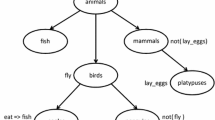Abstract
Knowledge processing methods are an important resource for robots that perform challenging tasks in complex, dynamic environments. When applied to robot control, such methods allow to write more general and flexible control programs and enable reasoning about the robot’s observations, the actions involved in a task, action parameters and the reasons why an action was performed. However, the application of knowledge representation and reasoning techniques to autonomous robots creates several hard research challenges. In this article, we discuss some of these challenges and our approaches to solving them.




Similar content being viewed by others
References
Beetz M, Jain D, Mösenlechner L, Tenorth M (2010, to appear) Towards performing everyday manipulation activities. Robot Auton Syst
Beetz M, Tenorth M, Jain D, Bandouch J (2010) Towards automated models of activities of daily life. Technol Disabil 22
Brooks R (1991) Intelligence without reason. In: Proceedings of the twelfth international joint conference on artificial intelligence, Sidney, Australia, pp 569–595
Brooks R (1991) Intelligence without representation. Artif Intell 47:139–159
Coles LS, Rosen CA, Raphael B, Garvey TD, Duda RO (1969) Stanford Research Inst Menlo Park CA. Application of Intelligent Automata to Reconnaissance
Daoutis M, Coradeshi S, Loutfi A (2009) Grounding commonsense knowledge in intelligent systems. J Ambient Intell Smart Environ 1(4):311–321
Davis R, Shrobe H, Szolovits P (1993) What is a knowledge representation. AI Mag 14(1):17–33
Fellbaum C (1998) WordNet: an electronic lexical database. MIT Press, Cambridge
Fikes RO, Nilsson NJ (1971) STRIPS: A new approach to the application of theorem proving to problem solving. Technical Report 43r, AI Center, SRI International
Fikes RE, Hart PE, Nilsson NJ (1972) Learning executing generalized robot plans. Artif Intell 3:251–288
Getoor L, Taskar B (2007) Introduction to statistical relational learning. Adaptive computation and machine learning. MIT Press, Cambridge
Green C (1969) Application of theorem proving to problem solving
Gupta R, Kochenderfer MJ (2004) Common sense data acquisition for indoor mobile robots. In: Nineteenth national conference on artificial intelligence (AAAI-04), pp 605–610
Harnad S (1990) The symbol grounding problem. Physica D 42:335–346
Jain D, Waldherr S, Beetz M (2009) Bayesian logic networks. Technical report, IAS Group, Fakultät für Informatik, Technische Universität München
Klank U, Zeeshan Zia M, Beetz M (2009) 3D model selection from an Internet database for robotic vision. In: International conference on robotics and automation (ICRA)
Matuszek C, Cabral J, Witbrock M, DeOliveira J (2006) An introduction to the syntax and content of Cyc. In: Proceedings of the 2006 AAAI spring symposium on formalizing and compiling background knowledge and its applications to knowledge representation and question answering, pp 44–49
Mösenlechner L, Beetz M (2009) Using physics- and sensor-based simulation for high-fidelity temporal projection of realistic robot behavior. In: 19th international conference on automated planning and scheduling (ICAPS’09)
Nilsson NJ (1984) Shakey the robot. Technical Report 323, AI Center, SRI International
Nilsson NJ (1995) Eye on the prize. AI Mag 16(2):9
Richardson M, Domingos P (2006) Markov logic networks. Mach Learn 62(1–2):107–136
Simon HA (1982) Models of bounded rationality. In: Behavioural economics and business organization, vol II. MIT Press, Cambridge
Tenorth M, Beetz M (2009) KnowRob—knowledge processing for autonomous personal robots. In: IEEE/RSJ international conference on intelligent robots and systems
Tenorth M, Beetz M (2010) Priming transformational planning with observations of human activities. In: IEEE international conference on robotics and automation (ICRA)
Tenorth M, Nyga D, Beetz M (2010, accepted) Understanding and executing instructions for everyday manipulation tasks from the world wide web. In: IEEE international conference on robotics and automation (ICRA)
Acknowledgements
This work is supported in part within the DFG excellence initiative research cluster Cognition for Technical Systems (CoTeSys), see also www.cotesys.org.
Author information
Authors and Affiliations
Corresponding author
Rights and permissions
About this article
Cite this article
Tenorth, M., Jain, D. & Beetz, M. Knowledge Processing for Cognitive Robots. Künstl Intell 24, 233–240 (2010). https://doi.org/10.1007/s13218-010-0044-0
Received:
Accepted:
Published:
Issue Date:
DOI: https://doi.org/10.1007/s13218-010-0044-0




